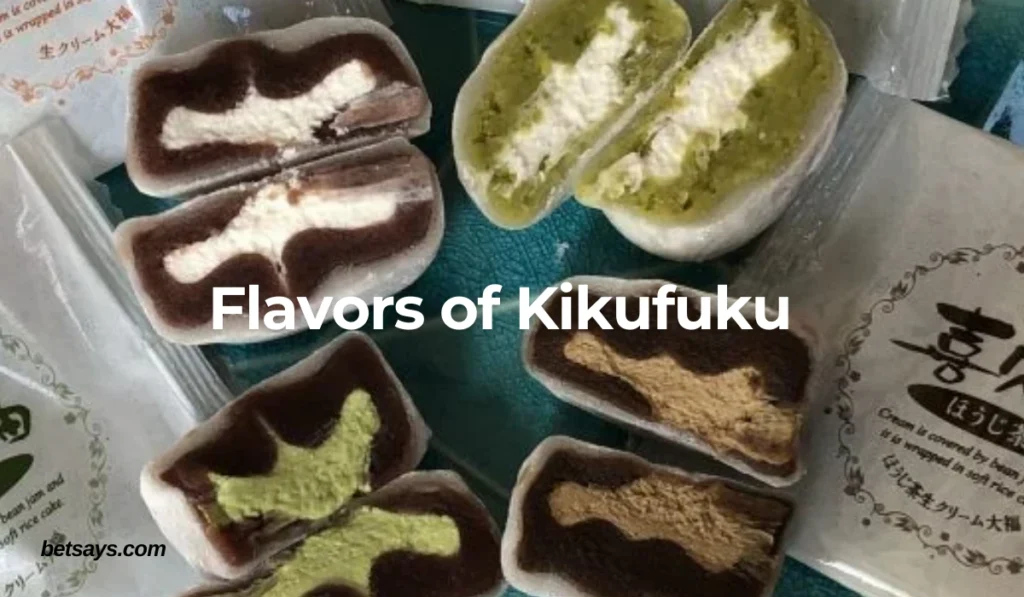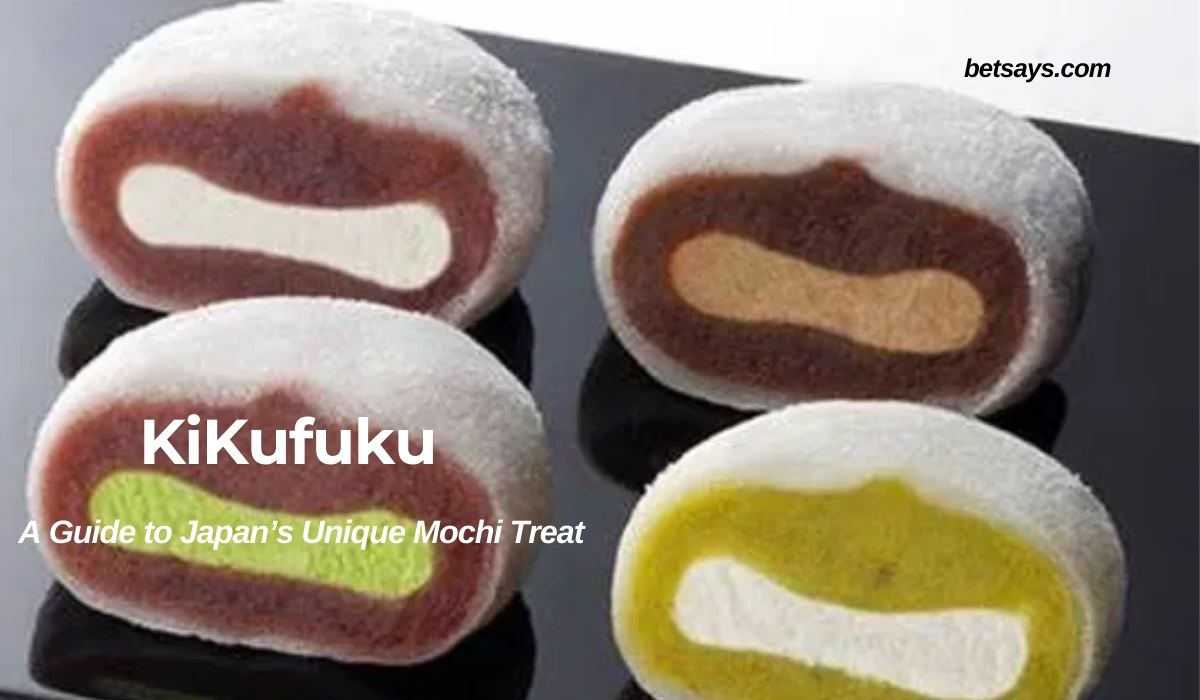KiKufuku: A Guide to Japan’s Unique Mochi Treat
Kikufuku is one of Japan’s most beloved traditional sweets, a soft and chewy mochi filled with a creamy and flavorful filling. Originating from Sendai in Japan’s Miyagi Prefecture, this dessert has captured the hearts of locals and tourists alike. Its popularity even spread internationally, thanks partly to the anime Jujutsu Kaisen, where Gojo Satoru expresses his love for this sweet treat. In this article, we will explore the origins, flavors, and cultural significance of Kikufuku, as well as a guide on how you can try or even make Kikufuku at home.
What is Kikufuku?
Kikufuku is a type of wagashi, or Japanese confectionery, characterized by a soft, glutinous rice exterior (mochi) and a sweet, creamy filling. This Japanese delicacy typically combines flavors like zunda (sweetened edamame paste), matcha (green tea), hojicha (roasted green tea), or anko (sweet red bean paste) with whipped cream for a smooth, balanced taste. Each bite offers a delightful blend of textures, with the chewy mochi balancing perfectly with the rich, flavorful filling inside.
The Origins of Kikufuku
Kikufuku was created by Ocha no Igeta Ichibancho, a tea shop in Sendai. This shop, established in 1920, is celebrated for its high-quality teas, which adhere to traditional Japanese tea standards. To complement its tea offerings, the shop developed Kikufuku, a snack that pairs perfectly with a warm cup of tea. Made from Miyagi’s locally sourced glutinous rice, it quickly became a local favorite and a sought-after souvenir. Today, Ocha no Igeta’s is so popular that it can also be found at the Kikusuian stall at Sendai International Airport, allowing travelers to take a piece of Miyagi’s culinary heritage with them.
Why is Kikufuku Special?
Kikufuku stands out from other Japanese desserts because of its unique filling combinations and cultural significance. Each flavor tells a story about the ingredients and customs of the Miyagi region. The traditional filling, zunda cream, is a sweetened paste made from edamame. This green soybean flavor has an earthy, mild sweetness that contrasts beautifully with the whipped cream. Other flavors, such as matcha and hojicha, add depth to the treat. Providing a slightly bitter yet refreshing taste that balances the sweetness of the cream.
Unlike other mochi desserts, its cream filling creates a richer and smoother texture. This creaminess adds a modern twist to the classic daifuku and appeals to people of all ages. Fans of Jujutsu Kaisen may recognize it as Gojo Satoru’s favorite snack. Who famously mentions it in the series, sparking curiosity among viewers.
Read more: Pat mcconaughey
Flavors of Kikufuku

It offers a variety of flavors to suit different palates. Below is a table summarizing some of the most popular Kikufuku flavors.
| Flavor | Description |
|---|---|
| Zunda Cream | Sweet edamame paste with cream; earthy and mildly sweet |
| Matcha | Green tea flavor; slightly bitter, balances sweetness with a creamy texture |
| Hojicha | Roasted green tea; nutty and less intense than matcha |
| Anko | Red bean paste with cream; classic Japanese sweetness |
Each flavor adds a unique dimension to the experience, from the nutty taste of hojicha to the traditional sweetness of anko. These flavors are designed to pair well with Japanese teas, making Kikufuku a versatile snack.
How to Enjoy Kikufuku
This is traditionally enjoyed with tea, especially matcha or sencha. The delicate sweetness of the filling complements the slight bitterness of Japanese tea. Enhancing the flavors of both the tea and the dessert. This combination makes Kikufuku a staple in tea ceremonies and a favorite among Japanese dessert enthusiasts. During the summer, it can also be enjoyed with a refreshing iced tea, adding a seasonal twist to the experience.
To fully enjoy the texture and flavor, this is best eaten fresh. If you purchase Kikufuku from a store or a souvenir shop, keep it in the freezer until you are ready to eat it. Freezing helps preserve the freshness of the mochi and filling, which can be thawed when you’re ready to enjoy it.
Read more: Best milk for matcha latte
Making Kikufuku at Home
Creating at home can be a rewarding experience. However, making mochi from scratch can be challenging, especially if you’re attempting it for the first time. Here’s a simplified guide to making at home:
- Prepare the Filling: Choose your desired filling, such as zunda, matcha, hojicha, or anko. You’ll need to blend the filling with whipped cream until smooth.
- Make the Mochi Dough: Mix glutinous rice flour with water and sugar, then microwave it until it becomes a sticky dough. Knead until smooth.
- Assemble the Kikufuku: Flatten small balls of mochi dough, add a spoonful of filling in the center, and fold the edges over the filling until it’s completely enclosed.
- Freeze and Enjoy: For the best texture, freeze your briefly and defrost before eating.
If you’re new to making mochi, watching a tutorial can be helpful in understanding the process. Especially the tricky part of wrapping the filling with the mochi dough.
Read more: Gojo happy
Frequently Asked Questions
Where can I buy Kikufuku?
Kikufuku is primarily found in Sendai, Japan, especially at Ocha no Igeta Ichibancho and Kikusuian stalls at Sendai International Airport.
What are the most popular flavors?
The most popular flavors include zunda cream, matcha, hojicha, and anko.
How should I store Kikufuku?
Keep Kikufuku in the freezer to maintain its texture and freshness. Defrost before eating.
Can I make Kikufuku at home?
Yes, but it requires patience and practice. Mochi dough can be tricky to work with, especially for beginners.
Conclusion
Kikufuku represents a beautiful blend of traditional Japanese ingredients and modern flavors, making it a unique and memorable dessert. Whether you enjoy the earthy sweetness of zunda, the bitterness of matcha, or the nutty warmth of hojicha, it offers something for everyone. Each bite combines the soft, chewy texture of mochi with a rich and creamy filling, providing a delightful balance that pairs perfectly with a cup of tea.
For those interested in experiencing Kikufuku, visiting Sendai is the best option. However, with a bit of patience and the right ingredients, you can recreate this Japanese delicacy at home. It, as seen in Jujutsu Kaisen, is more than just a snack; it’s a piece of Japanese culture that connects people through shared flavors and experiences.
So, the next time you have a craving for something sweet and unique, remember Kikufuku—a treat that’s as rich in flavor as it is in tradition.







